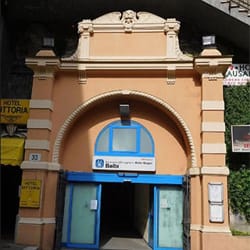Genoa is not only famous for being a rich city of bankers, merchants and shipowners, but also diplomats, Church authorities, princes and even kings used to call Genoa their home.
For this reason the Rolli Palaces were built and I’ve heard that the term Rolli comes from the term roles.
The buildings were cataloged on the basis of their prestige in order to accommodate important personalities visiting the city and if you visit such palaces you’ll see they have one thing in common: they have Genoese style floors.

Genoese style floors are the Ligurian variant of the Venetian floors of the sixteenth century.
The Genoese people have managed to make the Venetian technique their own, inserting unique characteristics and this is how the Genoese floor was born.
The Genoese floor, also known as Genoese ‘grit’, is a very thick and very hard surface, which involves a mixture of marble granules, limestone, and brick dust.
Along with marble and brick, other materials may also be present, including river pebbles or even semi-precious stones.
The Genoese floors are also characterized by the creation of mosaic-like patterns which embellish the floor, transforming it into a real work of art.
The main advantage of the Genoese floor is undoubtedly its high aesthetic performance.
It is in fact an elegant floor, considered to be of high value, capable of embellishing every room in which it is laid with its mere presence.
The mosaics can follow any design, create writings (like the date of the inauguration of the building) and therefore environments can be customized one hundred percent and give life on the floor to real works of art that are unique in their kind.
Many old homes have this kind of floor and even those who don’t like it keep it because they can understand its value.
They don’t fit very well with modern furniture but they have many advantages: they are resistant and easy to keep clean.
It is one of the most resistant floors to the passage of time, to foot traffic, even rather violent impacts, given that it is a very thick floor.
I remember dropping all sorts of things on it at my grandmother’s home when I was a child and it was so easy to clean.
It is important to clean it right away though because the material they are made of is very porous and it absorbs liquids, potentially staining such floors.
It is essential to ensure that no corrosive, oily or very dark colored liquid substance falls on the floor, for example, vinegar, sugary drinks, red wine, coffee, oil.
It is important to remember, however, that this negative element is temporary.
In fact, with the passage of time the degree of absorption of the Genoese floor decreases drastically so the newer they are the more delicate they are.
My grandmother used to say that it is possible to make sure that the absorption power of Genoese floors decreases quickly by washing the entire surface with water and a neutral detergent, such as Marseille soap, for example, very frequently, even on a daily basis.
Among the other cons that should be taken into consideration, the impossibility of laying the Genoese floor on a pre-existing floor in most cases, given that it is a very thick surface.
This affects the timing of the construction of the Genoese floor, which in themselves is already quite long.






























































